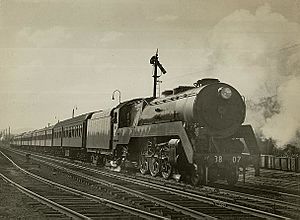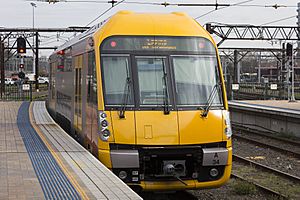Cardiff Locomotive Workshops facts for kids
The Cardiff Locomotive Workshops is a big place where trains are fixed and built. It's now called the Cardiff Maintenance Centre. You can find it near Newcastle, Australia. It's right next to the Main North railway line, between the Cockle Creek and Cardiff train stations.
Today, a company called Downer Rail uses the site. They put together, fix, and store different types of trains there.
Contents
Where it all Began: Early Train Workshops
Long ago, the Hunter River Railway Company started small workshops. These were near what is now Civic station in Newcastle. These small workshops grew into the Honeysuckle Point Workshops.
As the train network in the north grew, so did these workshops. Even when the Hawkesbury River Railway Bridge connected the northern lines to Sydney in 1889, the workshops kept growing. But by 1925, it was decided to build a brand new, modern workshop. This new place would be much bigger and allow for more growth.
Building the Cardiff Workshops
In November 1925, a large piece of land was bought for the new workshops. It was 172 acres (about 70 hectares) of swamp land. The plans for the new workshops were finished quickly. Building work started in the middle of 1926.
Train tracks were connected to the main line by April 1926. A platform for workers was ready by June. By September, all the train tracks were in place. The foundations for the buildings were nearly done. The steel frames for the buildings started going up in early 1927. By the end of 1927, most of the buildings were finished.
New machines and tools arrived throughout 1927. Two huge 75-ton cranes were put into the main repair shops. By early 1928, the first trains arrived for repairs. The very first train to leave the new workshops was locomotive 3364. By June 1928, the Cardiff Workshops had already fixed 14 locomotives and 15 train boilers.
Official Opening and Design
The Cardiff Locomotive Workshops officially opened on March 1, 1928. By this time, everything was working fully. The old Honeysuckle Point Workshops became a garage for company cars. They also fixed train tracks there.
The Cardiff Workshops were very modern for their time. Engineers from other places came to see how they were built. The main building covered a huge area, about 14,000 square metres. Inside, there was a special platform called a traverser. This traverser could move trains sideways. It connected five incoming tracks to 22 repair bays.
The complex also had other areas. These included a blacksmith's shop, a spring shop, and places to fix wheels and boilers. The manager's office was located near the main train line.
Trains Fixed and Built at Cardiff

At first, Cardiff Workshops repaired trains used in the Newcastle area. These included passenger trains like the 30 class and freight trains like the 19, 24, and 26 classes.
Later, the workshops were given specific types of trains to fix. Cardiff became known for repairing passenger trains like the 34 and 35 classes. They also fixed freight trains like the 53 and 55 classes.
Cardiff also built new trains. They built 12 non-streamlined 38 class locomotives between 1946 and 1949. These included numbers 3807 to 3829. Cardiff also built two 58 class freight locomotives, 5807 and 5813. Locomotive 5813 was the very last steam train ever built in a New South Wales Government Railways workshop.
Helping During World War II
During World War II, many factories helped with the war effort. The Cardiff Workshops were no different. A large ammunition factory was built nearby. Cardiff helped by making many tools and parts for this factory. Because of this, a special Tool Room was added to the workshops. At this time, about 1,200 people worked at Cardiff.
Handling Big Garratt Locomotives
In 1952, very large Garratt locomotives, called the 60 class, started running. These trains were 109 feet (33.22 metres) long. They were too long for the traverser at Cardiff. To fix them, part of the traverser was filled in. The huge overhead cranes then lifted the locomotives into place for repairs.
The Diesel Train Era
For several years, Cardiff repaired both diesel and steam trains. When steam trains stopped being fixed there around 1970, the workshops were reorganized.
The copper shop became an electrical fitting shop. Diesel engines were fixed in the area where boilers used to be. Train bogies (the wheel sets) and traction motors were assembled where the traverser used to be. The main repair shops kept their name. But new platforms were added to make it easier to work on the diesel trains.
In 1986, Cardiff became the main home for the 48 class diesel trains. The traverser area, which was filled in for the Garratts, was reopened. A section for repairing train wagons was also added. By April 1989, Cardiff became a place where trains could be prepared for their journeys.
Closing Down and New Beginnings
The Cardiff Maintenance Centre, as it was called from 1987, eventually faced changes. First, it was decided that all train wagons would be fixed at one special place. So, from April 1993, wagon repair work moved away from Cardiff.
Train locomotive work continued for a while. But then, a new plan started. The railway decided to rent new trains instead of owning them. A company called Clyde Engineering won this contract. They built a new depot on Kooragang Island to fix these new trains. Many older trains were then retired. The last trains left Cardiff Workshops in December 1993. The gates closed on January 7, 1994.
From 1994 to 1998, Cardiff was used to install radios in all the remaining trains.
Downer Rail Takes Over

In June 1998, a company called Downer Rail won a contract. They were going to build 140 new electric suburban trains, called the Millennium Trains. Downer Rail quickly got the old Cardiff buildings ready for this new work. They signed a seven-year lease with an option to buy the site.
Between 2010 and 2014, Downer Rail also helped build 626 A set carriages for Sydney Trains. By July 2020, they also finished building 626 B set carriages.
Downer Rail has also assembled new diesel locomotives at Cardiff. The main frames for these trains were built elsewhere. Locomotives built at Cardiff include:
- 1 V class train for Freight Australia: V544
- 4 90 class trains for Pacific National: 9032–9035
- 15 SCT class trains for SCT Logistics: SCT001-SCT015
- 14 LDP class trains for EDI Rail: LDP001-LDP014
- 34 TT class trains for Pacific National: TT01-TT08, TT101-TT126
- 3 WH class trains for Whitehaven Coal: WH001-WH003



